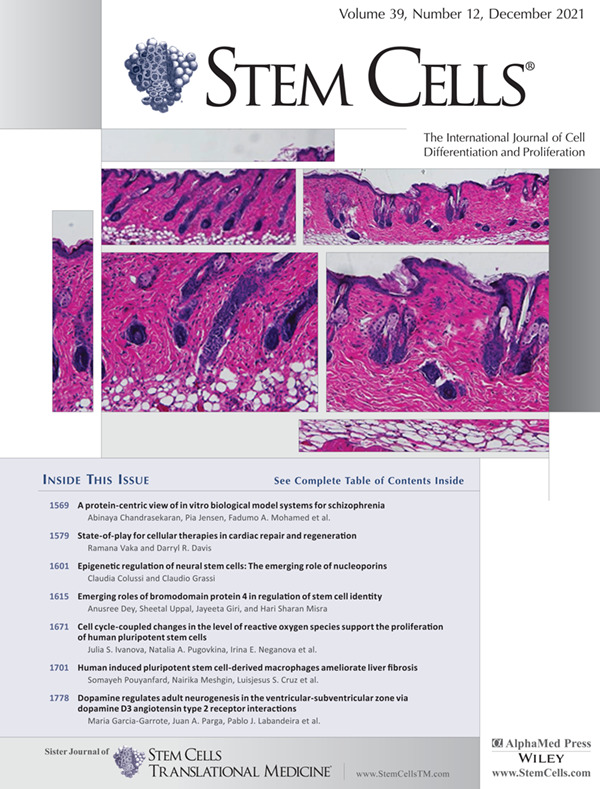HGF通过β-Catenin/TCF4/Nedd9信号通路驱动间充质干细胞的趋化迁移促进脊髓损伤的修复
IF 4
2区 医学
Q2 BIOTECHNOLOGY & APPLIED MICROBIOLOGY
引用次数: 0
摘要
移植的间充质干细胞(MSCs)可迁移到损伤部位并在该部位定居,从而大大有助于脊髓损伤(SCI)的修复。然而,这一过程通常效率不高,因为只有一小部分间充质干细胞成功到达目标病变区域。在脊髓损伤期间,肝细胞生长因子(HGF)的表达和分泌增加可作为一种趋化吸引剂,引导间充质干细胞迁移。然而,HGF影响间充质干细胞迁移的确切机制尚未完全明了。本研究的重点是揭示间充质干细胞在HGF作用下向SCI部位迁移的分子途径。研究发现,HGF可通过磷酸化LRP6或通过AKT和ERK1/2途径抑制GSK3β磷酸化,或通过增强TCF4的表达和核转位来激活间充质干细胞中的β-catenin信号转导。这种激活会导致 Nedd9 表达升高,从而促进病灶粘附的形成和 F-肌动蛋白的聚合,促进趋化性迁移。在损伤组织的 HGF 表达高峰期移植间充质干细胞,可显著改善神经再生、减少瘢痕形成并增强后肢活动能力。此外,延长 HGF 的释放时间可进一步促进间充质干细胞的迁移和移植,从而扩大再生效果。然而,抑制HGF/Met或干扰β-catenin或Nedd9信号传导会显著影响间充质干细胞的移植,阻碍组织修复和功能恢复。这些发现为间叶干细胞移植治疗SCI提供了理论基础和实践策略,突出了HGF调节间叶干细胞β-catenin信号转导,最终引发间叶干细胞趋化迁移的特定分子机制。本文章由计算机程序翻译,如有差异,请以英文原文为准。
HGF Facilitates the Repair of Spinal Cord Injuries by Driving the Chemotactic Migration of MSCs Through the β-Catenin/TCF4/Nedd9 Signaling Pathway.
Transplanted mesenchymal stem cells (MSCs) can significantly aid in repairing spinal cord injuries (SCI) by migrating to and settling at the injury site. However, this process is typically inefficient, as only a small fraction of MSCs successfully reach the target lesion area. During SCI, the increased expression and secretion of hepatocyte growth factor (HGF) act as a chemoattractant that guides MSC migration. Nonetheless, the precise mechanisms by which HGF influences MSC migration are not fully understood. This study focused on unraveling the molecular pathways that drive MSC migration towards the SCI site in response to HGF. It was found that HGF can activate β-catenin signaling in MSCs either by phosphorylating LRP6 or by suppressing GSK3β phosphorylation through the AKT and ERK1/2 pathways, or by enhancing the expression and nuclear translocation of TCF4. This activation leads to elevated Nedd9 expression, which promotes focal adhesion formation and F-actin polymerization, facilitating chemotactic migration. Transplanting MSCs during peak HGF expression in injured tissues substantially improves nerve regeneration, reduces scarring, and enhances hind limb mobility. Additionally, prolonging HGF release can further boost MSC migration and engraftment, thereby amplifying regenerative outcomes. However, inhibiting HGF/Met or interfering with β-catenin or Nedd9 signaling significantly impairs MSC engraftment, obstructing tissue repair and functional recovery. Together, these findings provide a theoretical basis and practical strategy for MSC transplantation therapy in SCI, highlighting the specific molecular mechanisms by which HGF regulates β-catenin signaling in MSCs, ultimately triggering their chemotactic migration.
求助全文
通过发布文献求助,成功后即可免费获取论文全文。
去求助
来源期刊

STEM CELLS
医学-生物工程与应用微生物
CiteScore
10.30
自引率
1.90%
发文量
104
审稿时长
3 months
期刊介绍:
STEM CELLS, a peer reviewed journal published monthly, provides a forum for prompt publication of original investigative papers and concise reviews. STEM CELLS is read and written by clinical and basic scientists whose expertise encompasses the rapidly expanding fields of stem and progenitor cell biology.
STEM CELLS covers:
Cancer Stem Cells,
Embryonic Stem Cells/Induced Pluripotent Stem (iPS) Cells,
Regenerative Medicine,
Stem Cell Technology: Epigenetics, Genomics, Proteomics, and Metabonomics,
Tissue-Specific Stem Cells,
Translational and Clinical Research.
 求助内容:
求助内容: 应助结果提醒方式:
应助结果提醒方式:


